U.S. Department of Transportation
Federal Highway Administration
1200 New Jersey Avenue, SE
Washington, DC 20590
202-366-4000
| < Previous | Table of Content | Next > |
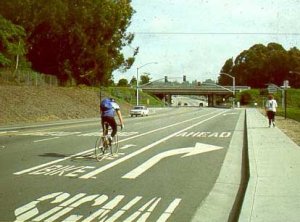 The
AASHTO Guide for the Development of Bicycle Facilities defines
a bike lane as "a portion of a roadway which has been designated by striping,
signing, and pavement markings for the preferential or exclusive use of bicyclists."
As levels of bicycling have increased in the United States, there has been
a growing amount of support for bike lanes on urban and suburban roadways.
Bike lanes are a preferred facility type in European countries, and in North
America, nearly every major city has made an effort in recent years to install
bicycle lanes, either as "pilot projects" (to test their success)
or, in many cases, on larger networks of interconnecting roadways. Several
small towns have led the way in establishing networks of bicycle lanes, particularly
college towns where there are high levels of student bicycle commuters (e.g.,
University of California at Davis and University of Texas at Austin).
The
AASHTO Guide for the Development of Bicycle Facilities defines
a bike lane as "a portion of a roadway which has been designated by striping,
signing, and pavement markings for the preferential or exclusive use of bicyclists."
As levels of bicycling have increased in the United States, there has been
a growing amount of support for bike lanes on urban and suburban roadways.
Bike lanes are a preferred facility type in European countries, and in North
America, nearly every major city has made an effort in recent years to install
bicycle lanes, either as "pilot projects" (to test their success)
or, in many cases, on larger networks of interconnecting roadways. Several
small towns have led the way in establishing networks of bicycle lanes, particularly
college towns where there are high levels of student bicycle commuters (e.g.,
University of California at Davis and University of Texas at Austin).
As a relatively new feature in the roadway cross-section, bike lane design has been the topic of much study in recent years. Bike lane design can be quite challenging in situations where the existing urban traffic patterns are complex and crosssections are already constrained by heavy traffic volumes. Designers throughout the country develop new and better solutions each year. This section includes excerpts from several sources, including Oregon's 1995 Bicycle and Pedestrian Plan and Philadelphia's Bicycle Network Plan.
Note: The Europeans have pioneered innovative bike lane design solutions. Lesson 22 includes a description of European approaches that have been successful.
As with the other bicycle facility design issues covered in this manual, bike lane design is covered in some detail by the AASHTO Guide for the Development of Bicycle Facilities. This text should be referenced for additional information.
Bicycle lanes serve the needs of all types of cyclists in urban and suburban areas, providing them with their own travel lane on the street surface. The minimum width of a bike lane should be 1.5 meters (5 feet) against a curb or adjacent to a parking lane. On streets where the bike lane is adjacent to the curb and the curb includes a 1-foot to 2-foot gutter pan, bike lanes should be a minimum of 4 feet wide (width does not include the gutter pan, since bicyclists are typically unable to use this space).
Wider bike lanes are recommended on streets with higher motor vehicle speeds and traffic volumes, or where pedestrian traffic in the bike lane is anticipated. Width measurements are taken from the curb face to the bicycle lane stripe.
Since bicyclists usually tend to ride a distance of 0.8 meters to 1.1 meters (2.5 feet to 3.5 feet) from the curb face, it is very important that the pavement surface in this zone be smooth and free of structures. Drain inlets and manholes that extend into this area cause bicyclists to swerve, having the effect of reducing the usable width of the lane. Where these structures exist and the surface cannot be made smooth, bike lane width should be adjusted accordingly. Regular maintenance is critical for bike lanes (see text in this section).
Bike lanes should be constructed to normal full-depth pavement standards since motor vehicles will occasionally cross them, or may use them as a breakdown area.
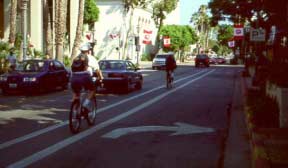
As a temporary solution, striping narrow lanes through intersections
may be an option where space is limited.
Where the minimum widths listed above cannot be met, it may be possible to provide an unmarked lane. Studies have shown that the bicyclist's perceived level of comfort is higher when a striped area is provided; therefore, this method can raise the bicycle level of service for the street. An unmarked lane is a striped area of 0.6 m (2 ft) wide or more that contains no markings or signing that would denote it as a bike lane. "Share the Road" signs may be used to caution motorists to be alert for bicyclists.
It is important to recognize that this is a temporary solution. Particularly on busy streets, narrow unmarked lanes will not adequately serve the needs of the majority of bicyclists.
Bicycle lanes are always located on both sides of the road on two-way streets. Since bicyclists must periodically merge with motor vehicle traffic, bike lanes should not be separated from other motor vehicle lanes by curbs, parking lanes, or other obstructions. Two-way bike lanes on one side of two-way streets create hazardous conditions for bicyclists and are not recommended.
On one-way streets, bicycle lanes should be installed on the right-hand side, unless conflicts can be greatly reduced by installing the lane on the left-hand side. Left-side bicycle lanes on one-way streets may also be considered where there are frequent bus or trolley stops, unusually high numbers of rightturning motor vehicles, or if there is a significant number of left-turning bicyclists.
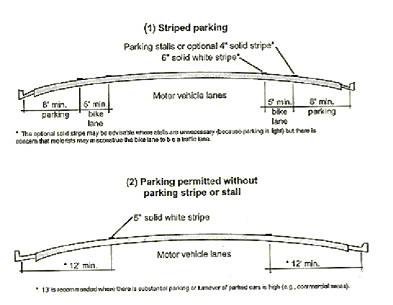
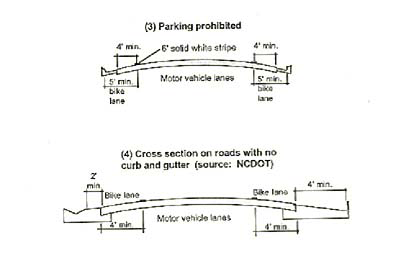
Bicycle lanes provided under different types of conditions.
Source: AASHTO Guide for the Development of Bicycle Facilities, 1991.
This creates a dangerous condition for bicyclists. It encourages illegal riding against traffic, causing several problems:
This configuration is difficult for cyclists: Riding on the right puts them in conflict with right-turning cars, but riding on the left puts them in conflict with cars merging into and out of the right-turn lane. The best solution is to eliminate the continuous right-turn lane, consolidate accesses, and create well-defined intersections.
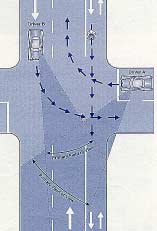
In both cases above, a wrong-way bicyclist is not in the
driver's main field of vision.
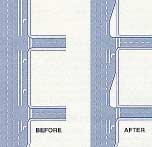
Continuous right-turn lane reconfigured to standard approaches.
Contra-flow bike lanes on a one-way street are not usually recommended. They may encourage cyclists to ride against traffic, which is contrary to the rules of the road and a leading cause of bicycle/ motor vehicle crashes. There are, however, special circumstances when this design may be advantageous:
A contra-flow bike lane may also be appropriate on a one-way residential street recently converted from a two-way street (especially where this change was made to calm traffic). For a contra-flow bike lane to function well, these special features should be incorporated into the design:
Note: Under no circumstances should a contra-flow bike lane be installed on a two-way street, even where the travel lanes are separated by a raised median.
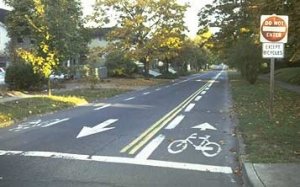
Contra-flow bike lanes can provide direct access to high-use destinations.
The Manual on Uniform Traffic Control Devices (MUTCD) section 9C addresses standard bike lane markings. The stripe between the bicycle lane and the adjacent motor vehicle lane should be a 100- millimeter (4 inch) wide white line (minimum width). Six- to eight-inch-wide lines provide an even clearer division of space, and are highly recommended. Where parking is allowed next to a bike lane, the parking area should be defined by parking space markings or a solid 100 millimeter (4 inch) wide stripe.
Care should be taken to use pavement striping that is durable, yet skidresistant. Reflectors and raised markings in bike lanes can deflect a bicycle wheel, causing a bicyclist to lose control. If reflective pavement markers are needed for motorists, they should be installed on the motorist's side of the stripe, and have a beveled front edge.
While the 1988 edition of the MUTCD recommends the use of the diamondshaped preferential lane symbol in conjunction with bike lane signs, this symbol is often confusing for both the bicyclist and motorist. For this reason, subsequent editions of the MUTCD will probably eliminate the use of the diamond in bike lanes. The new standard pavement markings for bicycle lanes are the bicycle symbol (or the words BIKE LANE) and a directional arrow.
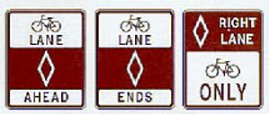
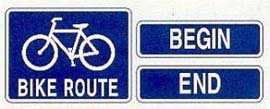
Bike lane signs should be replaced with bike lane stencils, with optional NO PARKING signs where needed.
The Manual on Uniform Traffic Control Devices (MUTCD) section 9B addresses standard bike lane signing. According to section 9B-8, the R3-16 sign should be used in advance of the beginning of a designated bicycle lane to call attention to the lane and to the possible presence of bicyclists. In locations where bicycle lanes are ending, the same R3-16 sign should be used, with the word ENDS substituting for the word AHEAD. The R7-9 or R7-9a signs should be used along streets where motorists are likely to park or frequently pull into the bike lane.
Diagonal parking causes conflicts with bicycle travel: Drivers backing out have poor visibility of oncoming cyclists and parked vehicles obscure other vehicles backing out. These factors require cyclists to ride close to the center of a travel lane, which is intimidating to inexperienced riders.
Where possible on one-way streets, diagonal parking should be limited to the left side, even if the street has no bike lane; on one-way streets with bike lanes, the bike lane should be placed adjacent to parallel parking (preferably on the right).
Bike lanes are not usually placed next to diagonal parking. However, should diagonal parking be required on a street planned for bike lanes, the following recommendations can help decrease potential conflicts:
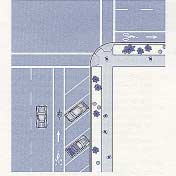
Bike lane next to diagonal parking, 8-inch stripe should
separate the areas.
If there is a bus stop at the near side of the intersection, a broken line should extend the length of the bus stop (no less than 15 meters [50 feet]), and the solid white line should resume on the far side of the intersection, immediately after the crosswalk. If a bus stop is located on the far side of the intersection, the solid white line on the far side of the intersection should be replaced with a broken line for a distance of at least 24 meters (80 feet) from the crosswalk (at this intersection, a broken line would still be required on the near side if there is right-turning traffic).
In general, right-turn lanes should be used only where warranted by a traffic study, as they present problems for both bicyclists and pedestrians:
The through bike lane to the left of a right-turn lane should be striped with two 100-millimeters- (4-in-) wide stripes and connected to the preceding bike lane with 0.9-meter (3-foot) dashes and 2.7-meter (9-foot) spaces. This allows turning motorists to cross the bike lane. A legend must be placed at the beginning of the through bike lane. Sign R4-4, BEGIN RIGHT TURN LANE, YIELD TO BIKES, may be placed at the beginning of the taper in areas where a through bike lane may not be expected.
Not all intersections can be widened to provide a right-turn lane. A bike lane to the left of rightturning cars should still be provided. One common configuration occurs where a right-turn lane is developed by dropping parking (see figure at right). Another configuration occurs where a lane is dropped and turns into a right-turn lane. Note: This is a difficult movement for bicyclists as they must merge left and find a gap in the traffic stream:
Exception #1: Heavy Right Turns If the major traffic movement at an intersection is to the right, and the straight through move leads to a minor side street, then the bike lane may be placed on the right and wrapped around the curve, assuming that the majority of cyclists will desire to turn right too. This often occurs where a highway is routed over local streets and the route is indirect.
Exception #2: Tee Intersections At a Tee intersection, where the traffic split is approximately 50 percent turning right and 50 percent turning left, the bike lane should be dropped prior to the lane split to allow cyclists to position themselves in the correct lane. Where traffic volumes are very high, a left- and right-turning bike lane should be considered.
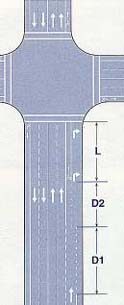 |
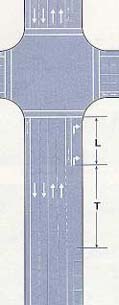 |
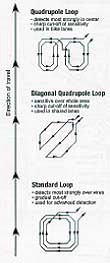 |
Above left: Bike lane left of right-turn lane developed by dropping a travel lane. Above center: Bike lane left of right-turn lane developed by dropping parking. Above right: Different loop configurations: The quadrupole loop is recommended for bike lanes.
Offset Intersections Care should be taken to ensure that motorists are not inadvertently encouraged to ride in the bike lane because of offset travel lanes. At intersections with offset lanes, dashed offset lane markings should continue through the intersection to direct traffic flow (MUTCD Section 3B-7).
Traffic Signal Actuation It is highly recommended that new on-road bicycle facilities include traffic signals that detect bicycles for all actuated signal systems. The Traffic Detector Handbook (FHWA-IP-90-002) recommends several bicycle-sensitive loop configurations (loops are wires installed beneath the pavement surface that detect the presence of vehicles) that effectively detect bicycles. The quadrupole loop is the preferred solution for bike lanes, and the diagonal quadrupole loop is preferred for use in shared lanes. One solution for existing intersection signals that do not respond to bicycles is to install a special pavement marking over the exact spot that a bicycle must stand in order to "trip" the signal.
Expressway Interchanges Expressway interchanges often present barriers to bicycle circulation. Designs that encourage free-flowing motor vehicle traffic movements are the most difficult for pedestrians and bicyclists to negotiate.
At-Grade Crossings Interchanges with access ramps connected to local streets at a right angle are easiest for bicyclists to negotiate. The intersection of the ramp and the street should follow established urban intersection designs. The main advantages are:
Grade-Separated Crossings Where it is not possible to accommodate pedestrians and bicyclists with at-grade crossings, grade separation should be considered. Grade-separated facilities are expensive; they add out-of-direction travel and will not be used if the added distance is too great. This can create problems if pedestrians and bicyclists ignore the facility and try to negotiate the interchange at grade with no sidewalks, bike lanes, or crosswalks. In some instances, a separate path can be provided on only one side of the interchange, which leads to awkward crossing movements. Some bicyclists will be riding on a path facing traffic, creating difficulties when they must cross back to a bike lane or shoulder (clear and easy-to-follow directions must be given to guide bicyclists' movements that are inconsistent with standard bicycle operation). To ensure proper use by bicyclists, structures must be open, with good visibility (especially underpasses).
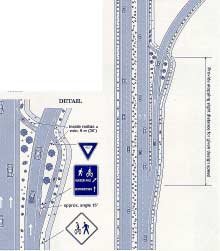
Exit ramp configuration for bike lane and sidewalks (urban design - not for use on limited-access freeways)
Other Innovative Designs These concepts are presented as examples of innovative solutions to bike lane design at freeway interchanges and intersections.
Traffic entering or exiting a roadway at high speeds creates difficulties for slower moving bicyclists. The following designs help alleviate these difficulties:
It is difficult for bicyclists to traverse the undefined area created by right-lane merge movements, because:
The following design guides bicyclists in a manner that provides:
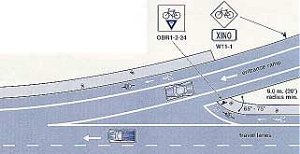
Right-lane merge – bike lane and sidewalk configuration (urban design
– not for use on limited access freeways).
Exit ramps present difficulties for bicyclists because:
The exit ramp design on the previous page guides bicyclists in a manner that provides:
This situation is particularly difficult for bicyclists. Warrants for dual turn lanes should be used to ensure that they are provided only if absolutely necessary.
The design for single right-turn lanes allows bicyclists and motorists to cross paths in a predictable manner, but the addition of a lane from which cars may also turn adds complexity: Some drivers make a last minute decision to turn right from the center lane without signaling, catching bicyclists and pedestrians unaware.
Bicyclists and motorists should be guided to areas where movements are more predictable, so bicyclists and motorists can handle one conflict at a time, in a predictable manner. A curb cut provides bicyclists with access to the sidewalk, for those who prefer to proceed as pedestrians.
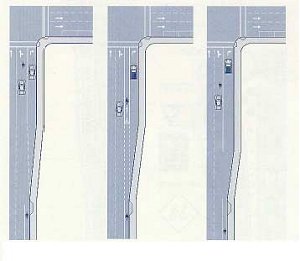
Bike lane through dual right-turn lanes. A. B. C.
A fourth design places an island between the rightturn lane and the optional through-right turn lane. This creates a more conventional intersection, separating the conflicts. This design is also better for pedestrians, as the island provides a refuge. Engineering judgment should be used to determine which design is most appropriate for the situation.
On bike lane retrofit projects where there is insufficient room to mark a minimum 1.2-meter (4-foot) bike lane to the left of the right-turn lane, a right-turn lane may be marked and signed as a shared-use lane to encourage through-cyclists to occupy the left portion of the turn lane. This is most successful on slow-speed streets.
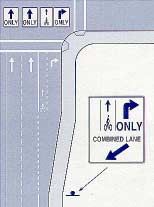
Joint use of a right-turn lane for through-bicyclist.
Redesign a local intersection to include bike lanes. Choose an intersection with a moderate level of complexity, and assume that curb lines can be moved at will in order to achieve your design. Prepare a report and graphics that show existing conditions and recommended modifications. Signalization changes (if necessary) should also be explained, as well as any advance striping and signing needed on the intersection approaches.
Text and graphics in this lesson were derived from the following sources:
Oregon Department of Transportation, Oregon Bicycle and Pedestrian Plan, 1995.
Philadelphia Department of Streets, Philadelphia Bicycle Facility Design Guidelines, 1998.
For more information on this topic, refer to:
AASHTO, Guide for the Development of Bicycle Facilities, latest edition.
ITE Technical Committee 6A-55, Review of Planning and Design Standards for Bicycle Facilities, 1997.
USDOT, Manual on Uniform Traffic Control Devices, Section 9, latest edition
| < Previous | Table of Content | Next > |
